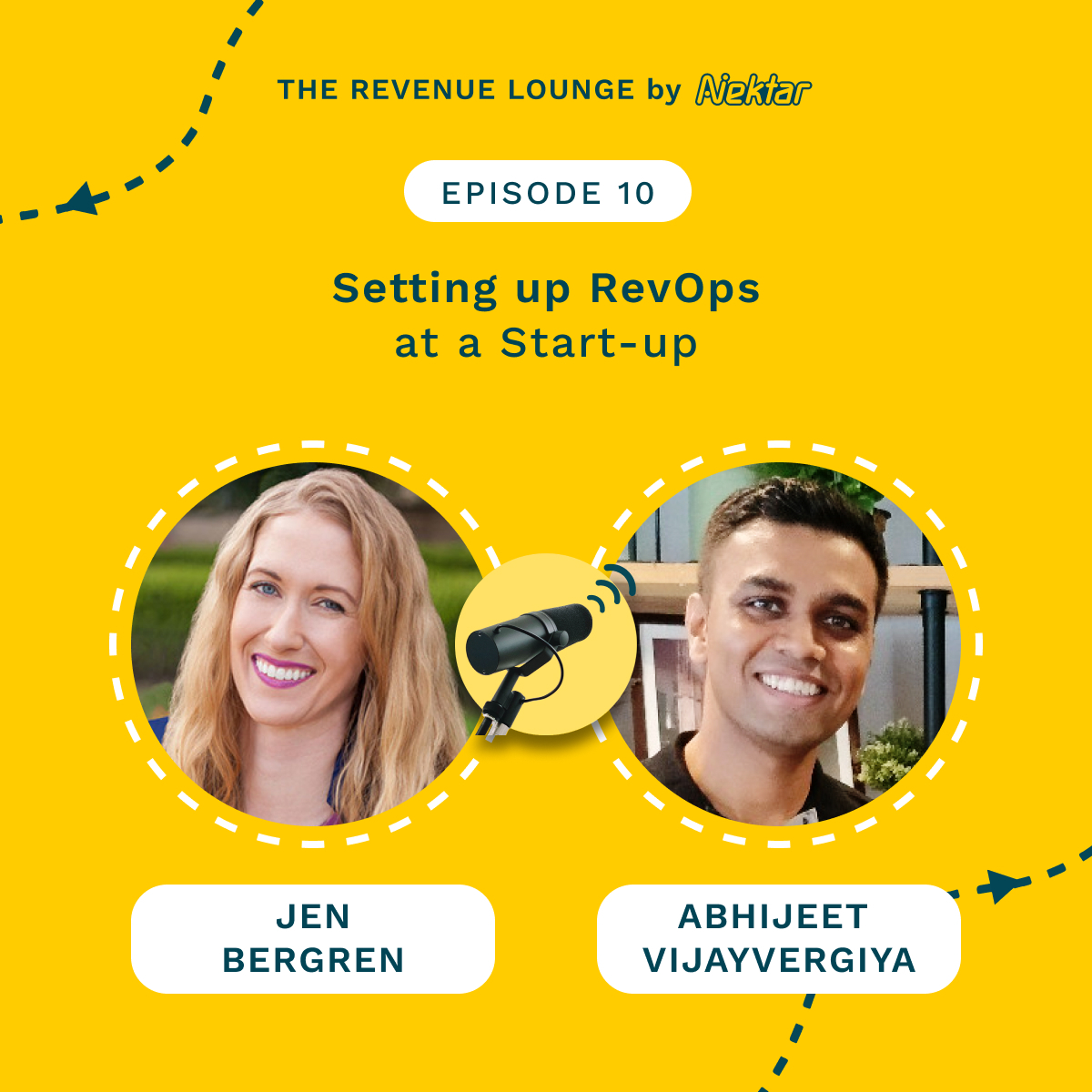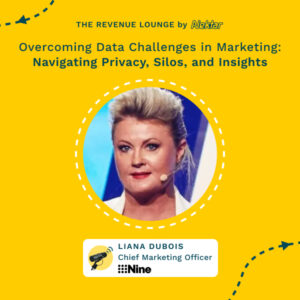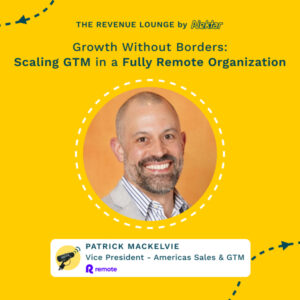Crafting a Data-Driven Customer Journey Roadmap ft. Cinthia Silva
October 9, 2024
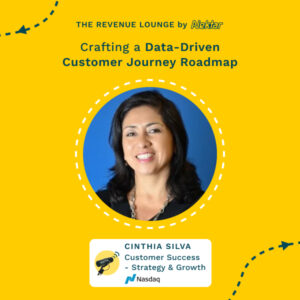
About
The Revenue Lounge
The podcast covers stories from leaders across RevOps, Sales, Customer Success, GTM, Data and Marketing about what drives these functions and what advice they would share with our listeners. With 3 seasons recorded, the podcast currently features 50+ enterprise leaders in the B2B SaaS domain. Tune in to hear from the best in the business
In this episode of The Revenue Lounge podcast, host Ankit Vashishtha interviews Cinthia Silva, a customer success leader who was named one of the top 10 women leaders in customer success in 2024. They discuss how to design and execute a data-driven customer journey roadmap that delivers real results. Key topics include customer segmentation, identifying customer needs and touchpoints, defining milestones, tracking progress with KPIs, ensuring stakeholder alignment, crafting effective playbooks, and more.
Guest Bio:
Cinthia Silva is a seasoned customer success leader who launched the customer success program at Nasdaq. She has deep expertise in developing and executing post-sales strategies to drive loyalty and growth. Cynthia takes a data-driven, customer-centric approach focused on creating frictionless experiences across the customer lifecycle.
Key Quotes:
“Segmentation is the starting point for all of this. It’s the first order of business in analyzing your customer base, and it ultimately will help you determine the journeys that you can create with tailored experiences.” (00:04:12)
“The reason playbooks are important is because it creates a consistent experience for your customers across teams and through with their journey.” (00:21:42)
“If there is collaboration happens already, that relationship internally is being established. And then there’s that transparency in in communication, whether it’s communicated verbally or is in the CRM.” (00:23:26)
Main Discussion Points:
– How to approach customer segmentation and use it to identify needs, touchpoints, and tailored journeys
– Importance of alignment across sales, marketing, product and other stakeholders
– Developing playbooks to enable consistent customer experiences
– Conducting continuous discovery conversations to uncover expansion opportunities
– Tracking customer health with indexes and metrics like usage, support tickets
– Creating joint success plans with milestones aligned to customer goals
– Leveraging data and insights to prioritize projects and defend their value
– Adapting strategies based on changing customer and business circumstances
– Preparing customers for digital customer success and self-service model

Ankit Vashishtha (00:03.383)
With evolving customer expectations and increasing touch points, organizations need a structured approach to anticipate needs, enhance interactions, and drive redentions. A well -crafted customer journey roadmap not only improves the customer experience, but also directly contributes to growth by identifying key milestones, optimizing engagement, and aligning internal team towards a common goal. Hello, everyone. Welcome to the Revenue Lounge Podcast. I’m your host, Ankit Vashishtha.
And in today’s episode, we’ll delve into how to design and execute a data -driven customer journey roadmap that delivers real results, from segmentation and risk mitigation, to leveraging customer health access, and developing actionable playbooks. We’ll explore strategies for crafting a roadmap that leads to stronger relationships, increase upsell opportunities, and sustain revenue growth. And joining me today is Cinthia Silva.
Cinthia is the customer success leader and has been named as one of the top 10 women leaders in customer success in 2024. She has user expertise to develop and launch GDM strategies, as well as scaling teams for the post sales motion. Hi, Cynthia. Thank you so much for joining us today. Love to speak with you.
Cinthia Silva (01:17.265)
Well, thank you so much for including me into this conversation. I love to geek out on all things customer success and sales process. So this is real pleasure for me. Thank you.
Ankit Vashishtha (01:30.062)
And we love to kind of look forward to kind of hearing from your experience and then kind of see how you scale your organization and scale the entire customer success org. And kind of leaning onto your experience, right? So before like as intro to get started, can you talk about the eight steps customer journey roadmap that you’ve developed and how it sort of transformed the customer success and helped transform the customer success team?
Cinthia Silva (01:56.433)
Yeah, of course, of course, I’d love to. This was sort of a labor of love, this customer success roadmap. And essentially what happened was, when I joined NASDAQ, I was tasked with launching the customer success program there. And a lot of times people say, NASDAQ, how are they? Well, they’re an exchange. How are they in tech? There’s a fintech arm. And that was the area that I was involved in. And they have a SaaS solution that they use for their.
financial banks and others that need trades or balance solutions. And so when I jumped in, the first thing we did was analyze the customer base. We put together an initial customer health index assessment, and then we went and talked to the customers. And during that process, we not only had to educate our customers on what our role was, because it was new to their journey, like where do you fit in all this, but we also had to define what the role was to our internal partner.
sales, marketing, product implementation. They were like, where do you fit, what value are you bringing, et cetera. And that’s when I started envisioning the customer success roadmap. And I knew that it couldn’t just be like something that you just plotted on a PowerPoint. Really data we know is so, powerful. really, the end result that I wanted and ultimately I felt I achieved was creating a strategic plan that analyzes and leverages client data.
And ultimately, we just want to plot a frictionless customer journey. really, when it’s executed correctly, the customer needs will align with your value proposition and the long -term vision. And the roadmap will essentially included segmentation analysis, customer journeys of this project list of in -flight and proposed projects, impact effort matrix, and then ultimately, a roadmap scheduler.
Ankit Vashishtha (03:19.213)
Okay.
Ankit Vashishtha (03:38.03)
Yeah.
Ankit Vashishtha (03:44.516)
Awesome. think this sounds really exciting. Obviously, not a lot of people would know that Nasdaq has a fintech arm and a SaaS product. And then how do you go about defining a customer success journey for that? And I’m sure it wasn’t probably very straightforward when you started that. Now, who’s looking at… Sorry, you were saying something.
Cinthia Silva (04:07.579)
I’m so
Ankit Vashishtha (04:07.786)
Yeah, I was saying that, yeah, I was saying that as somebody who’s sort of starting this fresh for their organization, right? Or kind of want to set it up for the first time, right? How do you begin the process of mapping a customer journey, right? And then like, how do you kind of go about segmentation and kind of use that data to kind of identify and plan the customer needs, the touch points? How would somebody get started with this?
Cinthia Silva (04:34.179)
Yeah, I think that’s a great question. And really, segmentation is the starting point for all of this. It’s the first order of business in analyzing your customer base. And it ultimately will help you determine the journeys that you can create with tailored experiences. It also helps you identify, based on how those segments fall out, how you engage. Is it going to be a high touch, mid touch, and then now a lot of people talking about tech slash digital touch?
And a lot of times the segmentations boil down to strictly NRR, ARR, however you look at this. And so that’s very high level. That is the starting point for a lot of companies. But really one of the things that you need to look at is use case, industry specific needs, obviously the contract value, and then the growth potential. And I think when you start that, and the way that I did it was I just literally went to our CRM, pulled down the data.
which is always really tricky. was really uncomfortable with it because I wanted perfect data and we know that that’s not possible. Once I got over myself, just said, exactly. It’s a huge challenge, not just for you and me, for everybody. Once I got over myself, I said, I’m just going to use what I have. That’s what I would recommend to people, use what you have and then start identifying them. When we did start to break those down into those segments, specifically by use case and industry, we realized,
Ankit Vashishtha (05:37.64)
Tell me about that.
Cinthia Silva (05:57.563)
who our ICPs were, who was kind of in the middle, and then who kind of the niche players were. And then again, that’s the absolute starting point to decide what sort of touch points and how are you going to engage with these customers.
Ankit Vashishtha (06:14.042)
I think this is interesting. then I think as we go through the customer journey, obviously there’s a sort of handoff across the different teams that the customer goes through. And then obviously I’m assuming when you look at the customer lifecycle and the sort of roadmap, there’s some sort of a handover and collaboration required across these different team members. And I think as they say, death and taxes are certain. And so is the conflict between
sales and customer success, right? So how do you then sort of go about ensuring that all stakeholders are aligned and there’s a common objective and goal that they go through when defining this roadmap?
Cinthia Silva (06:55.761)
Yeah, it’s such a great question because, know, I’ve been, I spent most of my career on the sales side. And I’m going to tell you, sales and marketing love to fight with each other. And I never understood it. I was like, you both want the same things. We’re both trying to attract new customers. And right then and there, and you know, in my career, I knew it, let’s collaborate. Cause a lot of times with some of the initiatives I was doing on the sales side were things that they were doing on the marketing side. So let’s get together. So.
Ankit Vashishtha (07:09.068)
Yeah
Cinthia Silva (07:20.615)
For me, the importance of collaboration cannot be overstated. And quite frankly, the odds for the success of your projects or initiatives is much, much better when you’re aligned with internal partners. And ultimately, when you do set up the right stage for this, these become your internal champions and vice versa. So the first thing I did was to reach out to marketing sales product and the implementation teams to get clarity.
on how they engage with the customers. Like, so where are the gaps? How do you do what you do? And also too, having been on that sales and understanding marketing side, it makes it much, much more easy. So if you’re not really versed on how they win, what winning looks like to them and what some of their tactics are, I would definitely learn. I would understand because then you come in, instead of this kind of defensive posture, you’re coming in and saying, hey, I’m assuming that you all are looking to do X, Y, Z. Is that correct? But how does it work here? That sort of engagement,
really takes people off guard and then asking for their input on best practices. I don’t know anybody who’s gonna refuse that conversation. And ultimately what really helped me was looking for those, doing my homework and then looking for the joint wins. Because again, if you know what winning looks like for them and you know what you’re trying to accomplish, how can we work together? And again, I don’t know anyone who isn’t happy to have their name next to a project that’s successful.
It really, really, it’s like putting money in the bank. And once you establish that communication and trust, creating that alignment is much more easy because the people you’re working with are much more bought into your initiatives. And at the end of the day, if you don’t have people buying into your initiatives, they’re going to fail. They’re going to fail because they’re really sometimes actively work against you.
Ankit Vashishtha (08:43.564)
Yeah.
Ankit Vashishtha (09:03.694)
Right? So this is very important, right? I think if you’re not aligned and we don’t have a common objective in mind, I think it gets very, very difficult because as an organization, can’t be sort of pulling, every department can’t be pulling in different direction, right? I think this is very, very interesting point that you made and important point that you made. And looking at now coming back to the roadmap item, right? So think when you’re looking at, when you’re defining a roadmap, obviously you need to understand what kind of milestone.
you should be seeing, right? And how do you define what, how does those milestones sort of align with the customer journey roadmap, right? So, and how do you track progress? Because you can define milestones, you can define a customer journey, but it’s also hard KPI sometimes that you have to go back and look at, look at the success.
Cinthia Silva (09:49.339)
Yeah, yeah, that’s a great, great point because quite frankly, if there are no milestones, then how do you know if the customer is successful, ultimately, if they’re going to stick with you? So I look at this from two perspectives, like from a broader perspective.
the customer journey should be tracked in stages, right? That initial outreach, the sales motion, implementation, onboarding, relationship management, advocacy, right? I looked at my roadmap included the full, you know, that, you know, we always talk about the sales funnel, but we all know that it’s actually a bow tie, right? The sales funnel, the bow tie is where the post -sale growth happens. So my roadmap covered it all.
And when we’re creating the journeys, again, we were looking for the friction points and ways to address them, right? So, you know, so if you, that’s a great starting point to understand, okay, like where are the gaps and what can we do to make those, you know, resolve them as much as best as possible. And then ultimately develop playbooks, right?
playbooks ensure alignment with the internal partners. And this is also where collaboration was huge win for me on the journeys. Because I literally went to the teams, I’d already kind of laid the groundwork, but I said, hey, listen, I’ve got this maybe, you know, it’s bombastic, you know, goal of creating this this full, you know, like roadmap, but I’d love your take.
I did the legwork, I didn’t come to them and say, hey, fill in the blanks for me. I was like, here’s what I think happens throughout the stage. Where did I get it wrong? Where did I get it right? What actually happens? What should happen? That really, like from a broader perspective helped identify that internally. And then in terms of tracking milestones, you know, really there should be a handoff from sales to customer success and customer success needs to create a joint success plan with every customer.
Cinthia Silva (11:29.341)
That is so, so pivotal to the success because that’s where you identify the milestones. That’s where you’re doing your initial discovery. And if you’re having a proper handoff from sales to CS, sales is telling you, here’s the reasons that they bought, here are their pain points, here are the problems they’re trying to resolve. And or if you’re hopefully documenting everything in CRM, then you’ve got that double whammy. But if you didn’t have a clean handoff, ask the questions, conduct that discovery. And don’t…
Don’t identify the milestones as we see them, right? We can all be like, I need them to do this, this, and this in terms of adoption. What are they looking to achieve, right? And when you agree on what those milestones look like and then establish achievable timelines, say, hey, we can realistically get X, Y, D within this sort of time.
Focus on that time to first value with the customer, right? Like really, and again, I’m thinking this from a CSM perspective, monitoring like where did we hit any of those milestones? And the minute you hit one, make the customer aware of it because that demonstrates the value of the solution. That means that they’re making progress. And guess what? Everybody reports to someone else. They can then report it to their leaders. And at the end of the day, I’m going to probably harp on this, track everything in CRM.
or your customer success platform if you’ve got that or both.
Ankit Vashishtha (12:43.182)
Right. I think this is very important, right? I think aligning to those milestones and making sure that all key stakeholders that are sort of the touch point that the customer, everybody’s aligned to those kind of key indicators and making sure that we are tracking towards it. obviously the time when you’re doing that handover between sales and customer success, I think there’s a very, very critical junction for any organization because a lot of time the success or failure of the project.
whatever you’re doing, if that handover is not there, properly documented or recorded data points for that. Because you’ve seen instances where customer success has been sort of running pillar to post to end over here. Who bought the solution? What was their intention of buying the solution and choosing us as a vendor over anybody else? Because at the end, they are the ones who have to deliver the project or the solution or the product or the platform.
And also not just one time, I mean, they have to make sure that the customer is happy, successful, grows with us. And you talked about the bot, I think the actual growth happens once you pass the implementation phase, right? So, interesting and great point there.
Cinthia Silva (13:57.137)
Yeah, and I love that you brought that implementation phase to you because customers that fail to launch are doomed. You know I mean? We know like if they are, if the implementation is clunky or if it goes on forever, you know what I mean? It’s really, it’s not a great starting point. You have to do a lot of damage control as a result.
Ankit Vashishtha (14:14.391)
Right, right, right. Completely agree with that. then I think being on both sides, like buying solution as well as obviously selling solution for a long time. then if you don’t have a good start, then obviously it becomes very, difficult to bring it back on trail and make the project successful. And that brings me to the next point, right? So obviously we are tracking our milestones. We are tracking defined what success looks like or should look like. But how do you get enough?
get a feedback from the customer, how do you end up defining a health index for the customer, right? And how does sort of tracking that and then sort of making, how do you sort of infuse that back into changing any strategies, any kind of plans that you have, right? What would be your advice on that?
Cinthia Silva (15:01.627)
Yeah, yeah, you know, it’s so funny too, because customer health indexes are very important, but they’re so, so tricky, because they usually involve metrics such as usage, adoption rates, you know, are they putting in a lot of tickets, know, support tickets? Have they been with us a long time? How big is the relationship? Is there room to grow? And do we have champions at the account, right? And, but that’s some of the, maybe the measurable metrics, but then there’s also like that, that, you know,
the sentiment like from the sales perspective or from the CSM perspective. And that’s like, that can be super, super fuzzy. And to me, this is where segmentation can help you identify your best fit customers and the niche or even the bad fit customers to create journeys to match their needs, right? This is where like you start to notice, wow, the ones based on the metrics we’re using for customer health, these are the ones, maybe the highest value customers are like,
the ones that are the healthiest and maybe the lowest value or some in the middle are like not as healthy. If segmentation helps to identify, that’s because, know, we’re selling widgets and these people are focused on, you know, frozen foods or something else, right? Like they’re not, they don’t align. So that helps you identify that. And then ultimately, whether they might have like maybe a one -off use or niche use for your solution, the key is to manage their expectations from the start so that they don’t.
fail to launch, as I was mentioning before. ultimately, because again, like if every customer comes in and expects some sort of white glove treatment, I hate that term white glove. But you know what I mean? Not everyone should, quite frankly, like your highest value customers that are the best, you know, the ICP and best fit, they probably should because you want to work close to them because you’re going to probably grow with them long term. And that doesn’t mean we ignore the rest. That means that’s where we start to infuse.
more of those digital and one -to -many strategies. think digital customer success is a huge topic right now and rightfully so because when you create programs such as video libraries and guides and things on knowledge bases and communities where maybe they can talk to peers themselves, then a lot of the mid -to -lower level customers and maybe the mid -to -lower touch customers
Cinthia Silva (17:21.117)
can engage with others and self -serve, which let’s face it, a lot of people do want to self -serve, but you have to manage their expectations from the start. And the point is, the reason I’m going all the way around here is that sometimes if someone’s expecting that highest level, high touch treatment, and then they’re kind of given this other, that affects the health of them, because they feel like, I’m not getting what I was promised.
managing that expectation from the start and ultimately will help them onboard successfully because they know what to expect. And then ultimately, you need to when you even when you implement these solutions and, you know, determine customer health, you know, for your book of business, you really need to analyze and iterate it, I’d say once or twice a year, twice is probably very, that would be tough.
but it really depends on the size of your customer base because things change, right? And like one of the things like usage is very tricky because maybe you’ve got a big customer that has hundreds of users, their usage is always going to be high. That doesn’t mean that they’re in great shape. it’s very, there’s iterations on
Ankit Vashishtha (18:24.12)
Okay.
Ankit Vashishtha (18:27.688)
I think that’s very important. And I think, as you mentioned, there’s a lot of conversation about digital customer success and how to get to the self -serve model and prepare the customer to also expect some of these things to come their way. It’s not that suddenly you just push it and then you expect or you onboard and then say, hey, now this is the way that it will be. And then how do you prepare them?
during the sales cycle, during implementation, and then sort of give them right guidance. I think that’s a very critical point, an important point for this to be successful. I think, yeah.
Cinthia Silva (19:06.173)
I agree, I agree. And not just that, I also feel that digital strategies are good for all of your customers, because again, it might be the main strategy for your lower touch or tech touch customers, but all of them can use it. Like when you have a knowledge base or something with materials that are available, that’s open 24 seven.
Ankit Vashishtha (19:16.577)
Thank
Cinthia Silva (19:26.001)
They don’t need to call somebody. They don’t need to wait for Nemo response. If they can self serve and have like FAQs and things available, even your best customers can leverage that. So digital strategies are here to stay and as they should, quite frankly.
Ankit Vashishtha (19:38.04)
Right, right, right. Very, very important. then that brings to mind, and as I think we start preparing some of these strategies, right, I think, or these roadmap, I think one thing that we’ve always kind of talked about is that plan for the best, but be prepared for the worst, right? Which means that all your plans should have, you should be able to understand what risks it carries, right? And how do you kind of mitigate that risk, right? So.
In terms of the roadmap that you have defined and in of the work that you have done, how do you of anticipate the potential challenges? How do you wear customer shoes effectively or be in their shoes and then look at it? What would be your advice?
Cinthia Silva (20:19.783)
Yeah, yeah, you know, I think risk mitigation is definitely important. We need to be, you know, and this goes back to just being proactive, right? When you’re reactive, you’re just, you you’re left flat -footed and the customer’s felt like, you know, how are you gonna help me here? And ultimately, like the starting point for this, I think is Playbooks.
So I feel like for every stage of the journey, you need playbooks so that every interaction across the journey is consistent. But sometimes there’s outside factors that arise that affect your customer’s business, right? And it could be macroeconomic, we know economic downturns, or industry specific, maybe regulation, or some sort of like, you know, an industry scandal, like I just keep thinking about crypto a couple years ago, like that was a huge, and then they had a bunch of scandals. then, and so if you had customers that were heavily leveraged or involved in crypto, you know,
Ankit Vashishtha (21:00.001)
Yeah.
Cinthia Silva (21:05.693)
How do you kind of address that? And in those instances, I think you need to create playbooks to ensure that you’re adapting your approach and have consistent messaging across teams to kind of address, first of all, be aware of what’s happening, address it with your customers, have those kind of continuous discovery conversations. And I think discovery, a lot of people think discovery starts when the, I should say stops when the contract is signed, but discovery should happen across.
Ankit Vashishtha (21:13.72)
Yeah.
Ankit Vashishtha (21:25.986)
What?
Cinthia Silva (21:33.777)
the journey, it really should. When you are going in with curiosity, questions, smart questions, not high level questions, things that really matter, it really distinguishes you and then customers will tell you maybe some things you don’t know that are maybe happening at their companies. Hey, there’s a big reorg happening or there’s this or that. And then then that’s, cause that’s a risk too, that’s a churn risk. And then that can help you get ahead of that and adapt for that.
Ankit Vashishtha (21:44.429)
Yeah.
Thank
Cinthia Silva (22:00.251)
And so ultimately, like again, the journey and any roadmap, any playbook, any anything should be iterative based on the changing circumstances of the customer specifically and the business itself.
Ankit Vashishtha (22:13.942)
Right? No, no, I think it is very critical to be prepared, right? And adjust your playbooks or adjust sort of your strategy based on how it could be business acquired in macroeconomics. Right? So people change as well. I think new leaders come in, they bring in sort of their perspective, their priorities change as well. And I think it’s very important. You previously touched upon, upon sort of creating your playbooks, right? So in terms of how you work with your customers, sort of, can you give me some examples of what kind of playbooks?
that you’ve developed that could guide teams through various stages of customer journey, right? And how these playbooks have actually helped improve the customer interaction, right? So what kind of, how did it, what end results you were able to try with that.
Cinthia Silva (22:57.349)
Yeah, yeah. You know, and it’s like I said, when, I was developing my roadmap, I was looking at it from start to finish. was looking at it from first outreach all the way to advocacy. I really wanted to get, and again, just knowing, it it seemed bombastic, but I’m like, no, knowing that it will, you know, it’s going to iterate, but let’s put something down. And so essentially like I partnered with each individual team. I, we jointly developed playbooks for
Ankit Vashishtha (23:05.912)
Yeah.
Cinthia Silva (23:24.381)
marketing outreach, what does that look like? What should it look like? What’s the messaging, SCR, sales process, implementation, handoff to CS, renewal process and expansion process. And I’ll tell you right now, especially in customer success, this has been such a funny year, but the theme of 2024 has been about retention and expansion. Cause we all know that the cheapest revenue is growth with existing customers.
Ankit Vashishtha (23:27.118)
Mm
Ankit Vashishtha (23:45.72)
Okay.
Cinthia Silva (23:50.845)
So this was, this was crude. This has always been critical. It’s just some, some have been like, kind of like the sounding board this, this year, but, but those really literally playbooks for every interaction. And then again, I just need some of the ones that are very specific, but the reason playbooks are important is because it creates a consistent experience for your customers across teams and through with their journey. Because, you know, what I noticed having these conversations and it wasn’t unique to NASA because like every company people have a different perspective on,
Ankit Vashishtha (23:51.245)
Alright.
Ankit Vashishtha (23:55.726)
you
Ankit Vashishtha (24:02.968)
Mm
Cinthia Silva (24:20.285)
how things should be done. And when you create the playbooks, it’s just like, really, this is what we all agreed on. And if we need to make updates, then let’s do that and communicate that internally. And finally, the reason playbooks are so important too, is it’s helpful when you’re onboarding a new team member. So someone who’s coming in new, now they have somewhere to go. They know what the process is and they know what the messaging is for any circumstance.
Ankit Vashishtha (24:36.248)
Go.
Cinthia Silva (24:42.811)
We know that a lot of times people come in new, it’s peer to peer kind of training, which is absolutely fine, but isn’t it nice to have a starting point that’s written down for you and it’s much, much easier to kind of get going quicker.
Ankit Vashishtha (24:52.268)
Alright.
Ankit Vashishtha (24:56.206)
Absolutely. I think, as you talked about, I think the playbooks obviously help in getting somebody on board, plus making sure that everybody’s aligned in terms of what we expect our org to do. And also then gives a consistent experience to the customer when we go across implementation or sort of rolling that out. And then a very interesting point is that how do you then sort of align that? Because I’m going back to the BOTA model.
is that how do you see the role of customer success or optimizing that your touch points with the customer, across the customer journey in your retention and specifically growth as a salesperson? Right. I think for me, the most important is obviously making sure that the customer is happy, they retain and all of that. But how do I collaborate with my CST and how do I kind of see that? What can we do together or like opportunities for growth in the account?
Cinthia Silva (25:54.673)
Yeah, yeah, yeah. mean, again, I think if there is collaboration happens already, that relationship internally is being established. And then there’s that transparency in communication, whether it’s communicated verbally and or CRM, like to kind of have those notes in there. And I do think that this discovery on the, not just the sales person, because I think they’re just like, sales, no, the CSM as well.
And it doesn’t mean, think a lot of times CSMs are little worried about being tied to revenue. And by the way, it’s crucial right now. Everyone needs to be tied to revenue, especially with the advent of AI, which is a whole other topic, which is gonna take away all the menial tasks and we’re gonna need to be more strategic and more tactical. I think it…
Ankit Vashishtha (26:36.054)
All right.
Cinthia Silva (26:43.075)
those who don’t know how to sell or have commercial conversations, it all starts with discovery. And that doesn’t mean interrogating your customers like some of the sales methodology seems to preach. It means going and doing your due diligence about the customer’s business, their industry, and how your solution can solve their most pertinent problems, right? And you already know that, how the solution works. And then if you ask the right questions and promise only what you can deliver and bring unique insights because I…
All customers want to know what their peers are doing and what’s happening in the industry. And if you’re the one to bring that, you’re going to earn their trust and then you’re going to earn their long -term business. This is ultimately how to become a strategic advisor. This has talked a lot about a lot on customer success and a lot of individual contributors struggle with this. But this is how you do is by that comp playing the long game, know, really being invested in your customer, their business, sharing ideas that they can use and leverage.
And then it’s going to organically uncover expansion opportunities. But really as a CSM, in addition to that, discovery should be happening. But the first thing should be a joint success plan, whether it’s a new customer or it’s being transferred, a customer being transferred into your book of business for whatever reason. When you establish that joint success plan, establish those value milestones, understand the problems we’re trying to solve, understand what good looks like to them. It sets you up for success, them up for success. And I’m telling you right now,
That’s a happy retained customer and that’s one that’s going to happily tell you about growth opportunities because they know you’re not going to pounce all over them. They know that you have that curiosity and that you’re going to be much more tactical and strategic in working with them as they grow their business.
Ankit Vashishtha (28:22.542)
I think it’s very, very crucial, especially in the current market, how do we end up retaining and grow the customer? I think every single dollar it didn’t essentially should be weighed in gold. Because it’s not an easy market to go out and sell at this point of time. And then everybody’s very, very cost -conscious. I think having our customers with us and then
Cinthia Silva (28:37.403)
you
Ankit Vashishtha (28:51.522)
continue to drive value. I think very, very important point that you made is that discovery never ends just in the sales process. I think it’s important because the priority, the reason somebody bought a solution or product, it evolves. The requirement evolves. Their business priorities change. And how do you stay relevant with their priorities? I think that’s a critical path to look at it. And then that brings me to the next point in terms of
Cinthia Silva (29:06.503)
Yes.
Ankit Vashishtha (29:21.548)
Obviously, we are looking at data, are looking at a lot of customer data, the KPIs. But how do you define a data driven internal organization? How do you leverage data to align your stakeholders, align, create your own roadmap or buy in from your internal stakeholders and leadership?
Cinthia Silva (29:42.461)
Yeah, yeah. And again, this goes back to data. And it’s so funny because I find data super tedious, but I love the insights. So I might hate working with data, but I love the insights. So I’m going to go all in. And for me, it all started with, just created a project list. At the time, we had 32 projects that were in flight or in consideration. And depending on who you spoke to, they were all important. So we know how this goes, right? no, my project is the most important. So I literally just was like, OK, and we’re talking about
Ankit Vashishtha (30:06.808)
Yeah.
Cinthia Silva (30:12.239)
in Excel. This wasn’t like I wasn’t using a sexy, you know, tool. wish I did. I wasn’t. I know there many that are exist now. But really I just put them in a spreadsheet and I analyzed and ranked each product, our product project based on things like, you know, revenue generation or retention, you know, capabilities like the impact that would have there, the level of impact versus the level of effort it would be to kind of, you know, institute this project, the change management difficulty.
racy, right, who’s involved, right? And at what stage, what are the roadblocks? And most importantly, the whiff of them, right? What’s in it for me from the customer standpoint and the company standpoint. And then I literally, you know, just quantified those, you know, and, you know, like rate, rank them, analyze them and quantify them. And at the end of the day, what,
Ankit Vashishtha (30:50.574)
Go ahead.
Cinthia Silva (31:00.301)
what you find, especially with leaders, you know what I mean? Like they have everybody coming at them from every angle. And if you really want to get someone’s attention, when you quantify and you have like logic behind this, especially multiple data points that you write for whatever reason, it makes such a stronger case, not just for what you’re trying to do, but for what they can defend. They can now say, listen, I’ve got somebody who did this deep analysis. Here are the numbers. And another thing too, you know, a lot of times, you know, and I’m sure you’ve encountered this too, where
Ankit Vashishtha (31:20.237)
Yeah.
Cinthia Silva (31:29.497)
Somebody says, you know, like you go into a meeting, a critical meeting, and they’re like, this one XYZ initiative is super important. Let’s get this done. And then all of a sudden, six months later, it’s not that shiny anymore. And it gets forgotten. This sort of data backed.
analysis eliminates that because if someone wants to throw something off the roadmap and they’re like, okay, so that’s now become a priority. Well, let’s let’s reanalyze this. So it keeps your customer your projects alive. It helps you see them to fruition. It helps you defend the value of the project. And again, if you need to iterate, you should iterate because if something you know, world changing happens again, you probably do need to iterate. But this is a way to kind of just really stick to your guns and work on the things that really matter.
Ankit Vashishtha (32:05.432)
Alright.
Ankit Vashishtha (32:10.19)
No, I think what you mentioned is absolutely true. then it becomes, the way I would look at it, it is internal selling as well. Because when I look at it from a sales perspective, we keep talking about it. As a customer, there’s always fire. are all like leadership is struggling with 100 fires. I think they have to figure out which is the most burning problem that they have and which sort of the probably a million or a hundred million dollar problem that they’re going through.
want to solve. then I think the same thing, right? So how do you leverage data internal as well to sell your project or prioritizing that you want to do? No, awesome. This is great, right? So I think we have talked about how to define this roadmap, how to implement it, right? So we’d love to end up if you’re okay to share, right? So how sort of some of these things helped in your experience drive revenue growth, right? Or effectively look at increasing the
customer lifecycle value or loyalty based on these roadmap that you were able to implement. Would love to kind of hear your thoughts or stories, customer stories.
Cinthia Silva (33:15.077)
Yeah, yeah, yeah. mean, you know, I can’t get into specifics, but I can tell you that when we rolled this out, we did have like a couple of immediate six figure wins. And our ACV is higher. So that’s not like, like it wasn’t like you know, six figure in widgets. was, you know, obviously a much higher, you know, ACV solution, but that was huge for us. And part of the reason was because we were able to streamline some of the processes, especially on like on the sales side. So pre -sale.
was basically sped up the process internally instead of sometimes like some decision making that needs to happen or some terms that need to be addressed or whatever it might be, because we did have like a legal kind of stage as well. And that could be redlining things for a year, right? That helps speed up the process and really helped move the needle on a couple of things because of that alignment. It was just like, well, we all agreed on this. So why, like tell us
Ankit Vashishtha (33:48.705)
Yeah.
Cinthia Silva (34:14.181)
what needs to happen and it did. And also too, had immediate improvements and speed to the onboarding process. my goodness. One of the issues…
was people would just be in UAT forever because we had a very complex solution. And so if they wanted to sit with the implementation team for months and months and months and just never leave, it was like getting a little baby bird out of the nest. And so we were just basically like, okay, there’s boundaries here. And so what is it you need? And because we’d been developing our digital processes as well, that one too many strategies, we were able to…
Ankit Vashishtha (34:36.15)
Thank
Ankit Vashishtha (34:41.698)
Alright.
Cinthia Silva (34:50.653)
We presented it as we should as a positive. Hey, we’re now going to kind of forcibly move you out of UAT, but look at what we’ve done to kind of help bolster that. We’re not going away 100%. You’re still going to have a CSM to help kind of with that adoption. We’ve got these digital processes. And ultimately that did lead to like a lot of customers and especially a lot of like the customers with, you know, they have, you know, know, employees of all ages and people coming in.
Gen Z, Gen Y, they don’t really want to talk to anybody. They’d rather self -serve. So it was a big win in certain instances where they had some really smart people. were just like, great, show me where I go. And it just made that the renewal process much, much easier because they felt like we were very proactively trying to work with them and help solve problems in the way they needed them to be solved.
Ankit Vashishtha (35:20.993)
Yeah.
Ankit Vashishtha (35:39.468)
And this is very interesting and how to kind of cater to different audiences and then kind of align them on the success. Great, great. Thanks for sharing it, Cynthia. We are moving to the next section, which what we call as a lightning round or a rapid fire. Right, and quick, four or five questions. Love to kind of pick your thoughts around that. Any book that you sort of picked up.
read recently and that you like and sort of would be able to share.
Cinthia Silva (36:11.515)
Yeah, of course. I just finished reading The War of Art by Steven Pressfield. Excellent book. I love to stake on the ways we hold ourselves back, the excuses we use, the busyness to avoid the hard things that really will have the impact on our lives. I’ve definitely, and it’s a fast read, so I would recommend it. The War of Art.
Ankit Vashishtha (36:31.704)
Perfectly. I’ll put it in my next read list for sure. Yeah, definitely I’ll pick it up. You’ve been in customer success team. You’re sort of being a leader there. What’s your favorite part of being in customer success?
Cinthia Silva (36:36.553)
You should, you should. You could read it on a plane, probably.
Cinthia Silva (36:53.339)
it’s the same thing that I loved when I was on the sales side, working with customers, helping to solve their business problems, collaborating with peers to look for ways to create those impactful results for customers. Love it. Love engaging one -on -one.
Ankit Vashishtha (37:07.768)
Perfect. I don’t know if it is there, but is there any least favorite part of being in custom success?
Cinthia Silva (37:14.008)
Well, you know, it’s funny, know, as much as I love working with customers, what I don’t like about customer success is the loose definition. It means something different from one company to the next. And as a result, it can sometimes, you know, become customer service 2 .0. And this is why I feel like you really need to define it. And that’s one of the reasons I like for me that customer success roadmap was so crucial to prove the value quantify that.
Ankit Vashishtha (37:30.232)
Alright.
Cinthia Silva (37:39.965)
And then also, I think be tying yourself to revenue. If you’re not tied to revenue, you’re in a weak position. And I think in the future, that’s gonna change.
Ankit Vashishtha (37:50.087)
This is very, very important and sort of putting or sort of continuing on that. So any advice that you’ve received from someone that has stayed with you and you’d like to share with us.
Cinthia Silva (38:03.997)
Yeah, during the financial crisis in 2008, remember that? That was fun. I was sitting on a derivatives trading desk and it felt like the world was just crashing in New York City, crashing, which is where I’m at. So my boss at the time said, don’t pay attention to any of the noise, focus on what you can control, just keep doing your job. And I know he was just trying to focus me, but I kept that with me because I thought that’s right. I can’t control what’s happening outside of myself.
Ankit Vashishtha (38:09.708)
Mm
Ankit Vashishtha (38:16.12)
Bye.
Cinthia Silva (38:30.683)
I can control what I do and I would definitely recommend others to kind of hold that as much as possible.
Ankit Vashishtha (38:36.55)
Perfect. And while I think that’s a great piece of advice that stayed with you and obviously helped you focus, but is there any other piece of advice that you would want to share with people who are just starting their jobs and making their career?
Cinthia Silva (38:51.835)
Yeah, of course, of course. I would say the number one thing, don’t be afraid to stand out or try something new. I definitely kept myself small for a lot of my career because I just was like, there’s someone smarter, more educated with this, more that. Just do it. The best risk you can take is on yourself. it’s, you know what? It’s like, don’t be afraid to fail because sometimes those are where you get the best lessons. So always, always bet on yourself.
Ankit Vashishtha (39:17.058)
A great piece of advice and I think that’s something that holds a lot of us back. So we sort of, yeah, it’s okay. Let somebody else take it. I’m happy doing, staying in the background and doing things that, that, that I got.
Cinthia Silva (39:28.209)
you
Cinthia Silva (39:31.823)
It’s safe back here, but it’s not safe back there. It isn’t, it isn’t.
Ankit Vashishtha (39:35.278)
Perfect, perfect. That sort of brings us to the end of the conversation today, Cynthia. Any last piece of thoughts from your side or last?
Cinthia Silva (39:48.303)
No, I’ve really enjoyed this conversation on kid. think it’s timely too, because I think, know, like again, there’s with a lot of things changing like in tech, there’s so much evolution going on with AI. I would also encourage people if you’re not actively using AI, you should learn how to, you know, what tools your peers are using, adopt them proactively, don’t be afraid of them. It’s just simply a tool. Being strategic is the way that you’re really going to be and really kind of putting yourself out there.
is the way that you’re gonna stand out and AI is not gonna take your job if you’re the person coming in hot with ideas and presenting them, not afraid to present them.
Ankit Vashishtha (40:25.407)
I think that’s a great piece of advice. Rather than seeing AI as an enemy, or somebody who will replace you, how do you make it a friend and start using it to your advantage and then stay relevant and the way market is changing. It’s a great piece of advice. Pleasure speaking with you, Cynthia. Thank you so much for taking your time. What I really loved about that conversation was how
Cinthia Silva (40:42.692)
100%. Thank you, thank you. It’s such a pleasure.
Ankit Vashishtha (40:53.218)
like passionate about being customer centric. I would not just say customer success. think how passionate about being customer centric and doing everything which makes it sort of easier and better for the customer.
Cinthia Silva (41:05.714)
Definitely, definitely. That’s how we win, honestly. In the end, that’s how we’re going to win.
Ankit Vashishtha (41:10.582)
Right, right. Great. Thanks again, it’s been a lovely speaking with you.
Cinthia Silva (41:14.587)
and thanks to you. Have a great day everybody.
Ankit Vashishtha (41:17.112)
Thanks.

Ep #1: Navigating the Downturn with a Hyperfocus on Productivity
Listen Now
Ep #2: How to Win in Times of Uncertainty
Listen Now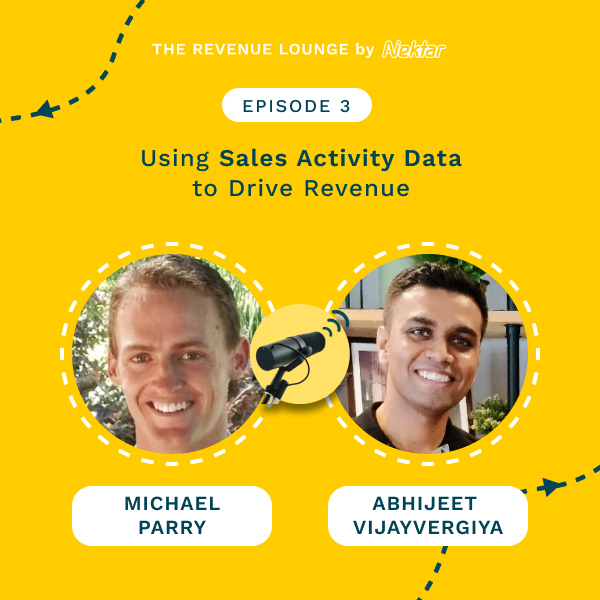
Ep #3: Using Activity Data to Drive Sales Productivity
Listen Now
Ep #4: Creating a Successful RevOps Roadmap
Listen Now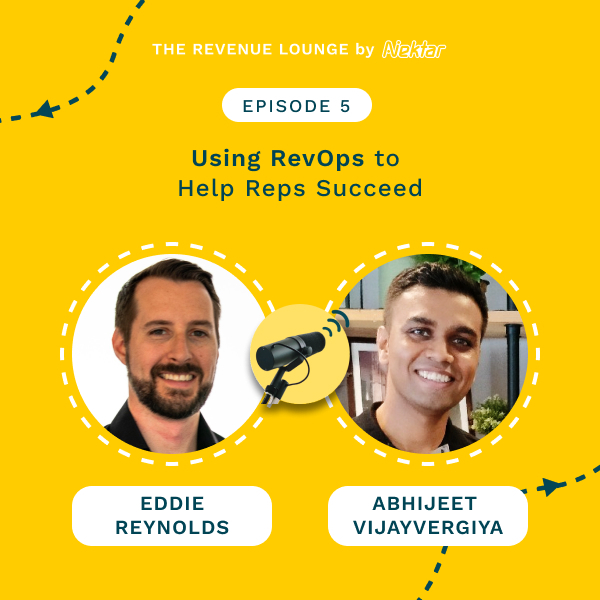
Ep #5: Using RevOps to Help Reps Succeed
Listen Now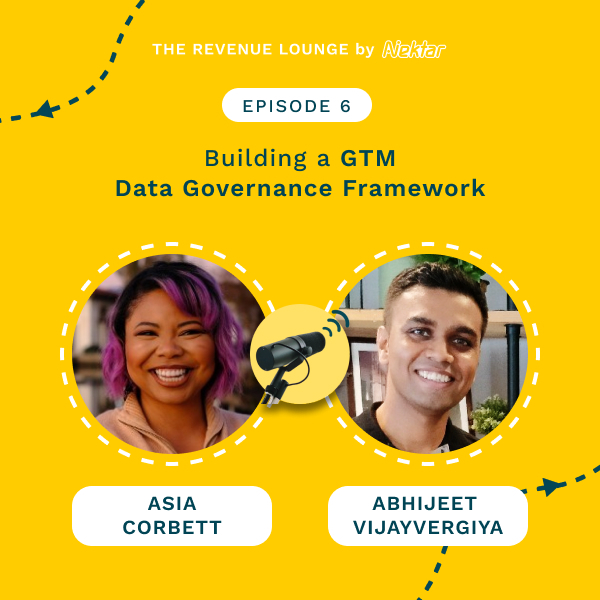
Ep #6: Building a GTM Data Governance Framework
Listen Now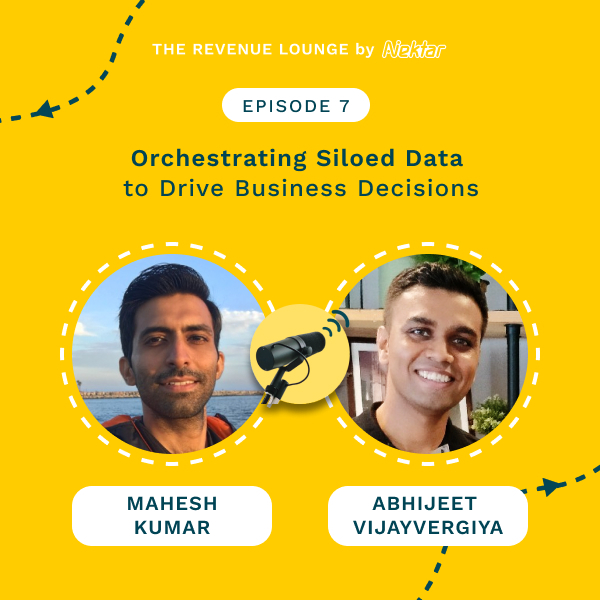
Ep #7: Orchestrating Siloed Data to Drive Business Decisions
Listen Now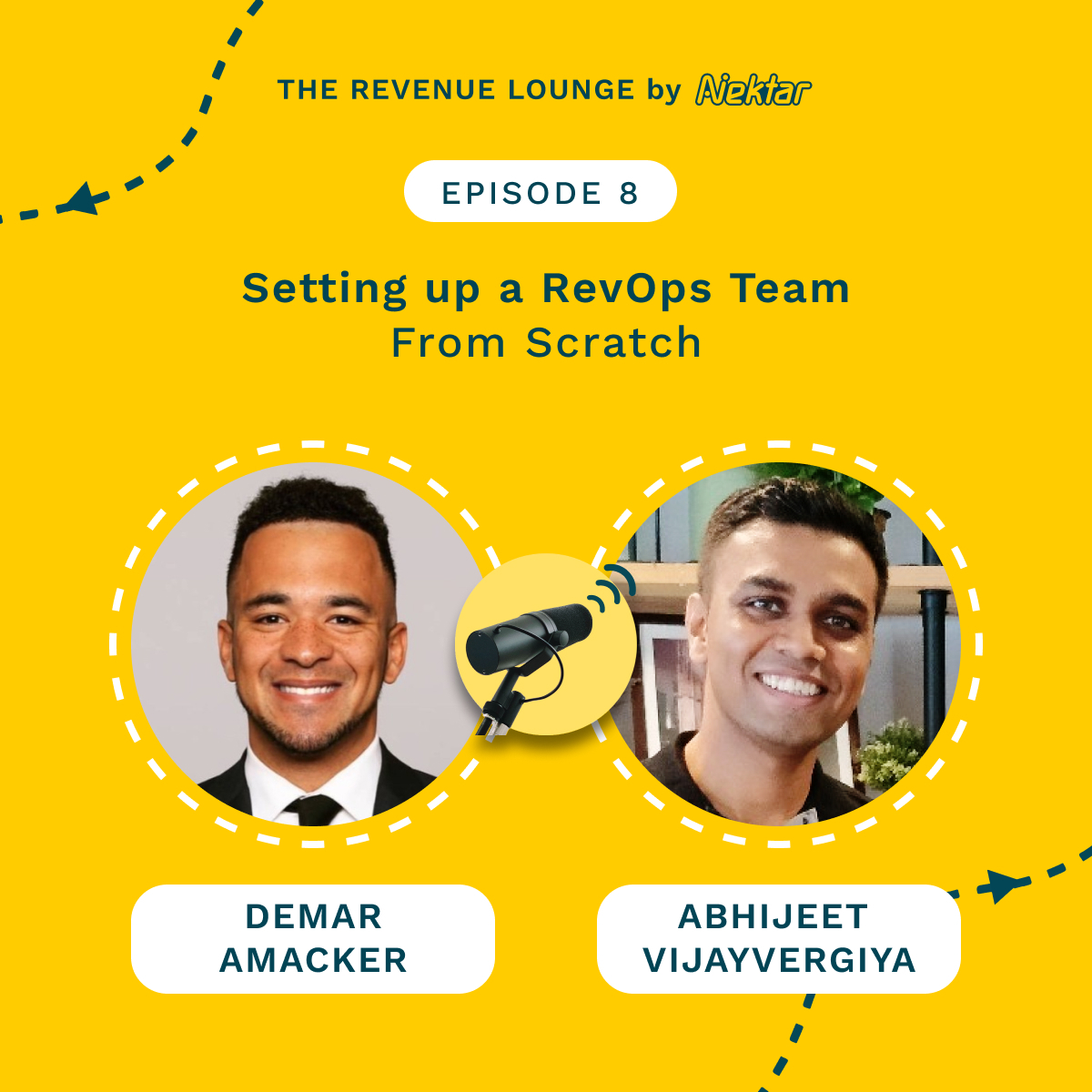
Ep #8: Setting Up a RevOps Team From Scratch
Listen Now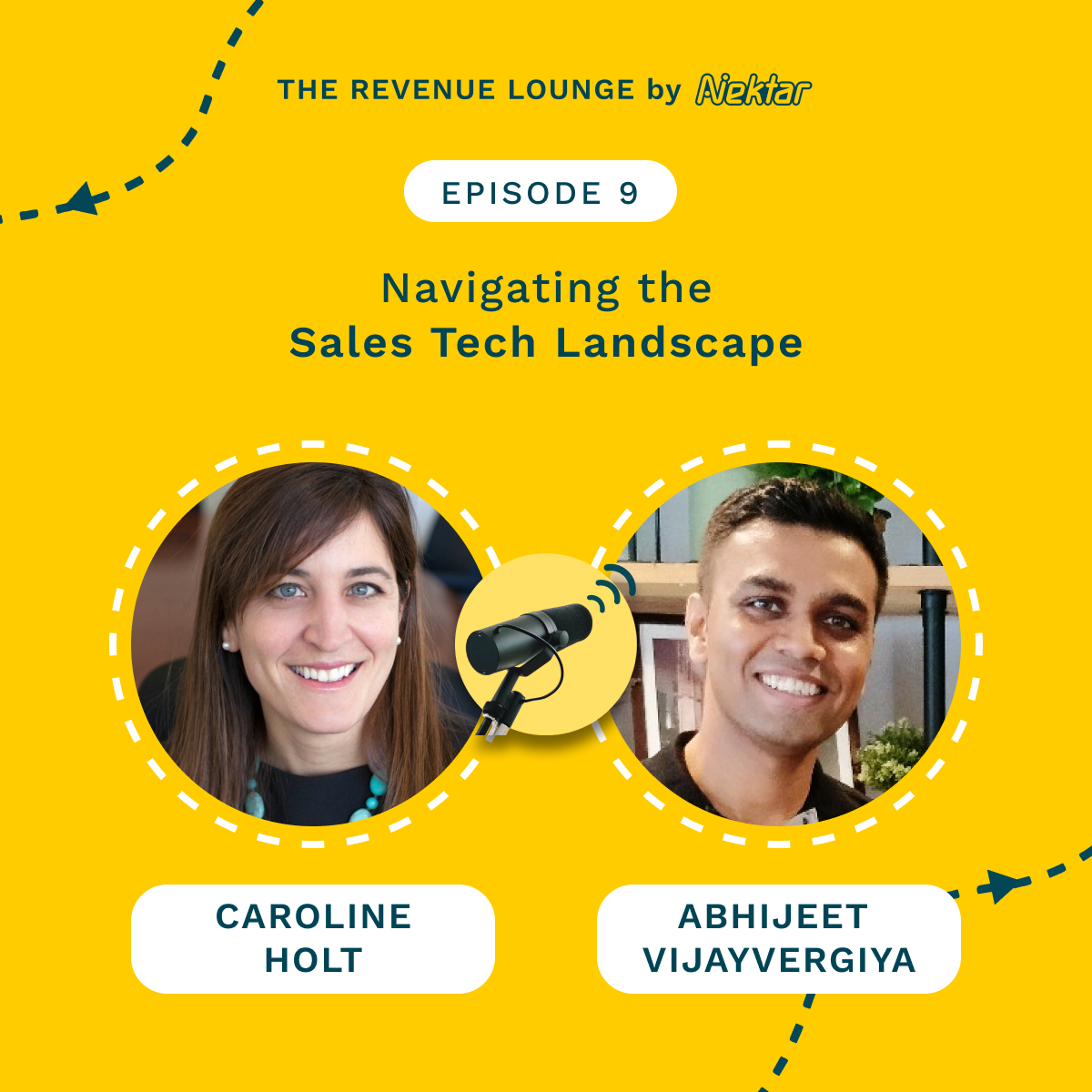
Ep #9: Navigating the Sales Tech Landscape
Listen Now